JEEP PATRIOT 2010 1.G Service Manual
Manufacturer: JEEP, Model Year: 2010, Model line: PATRIOT, Model: JEEP PATRIOT 2010 1.GPages: 496, PDF Size: 6.45 MB
Page 41 of 496
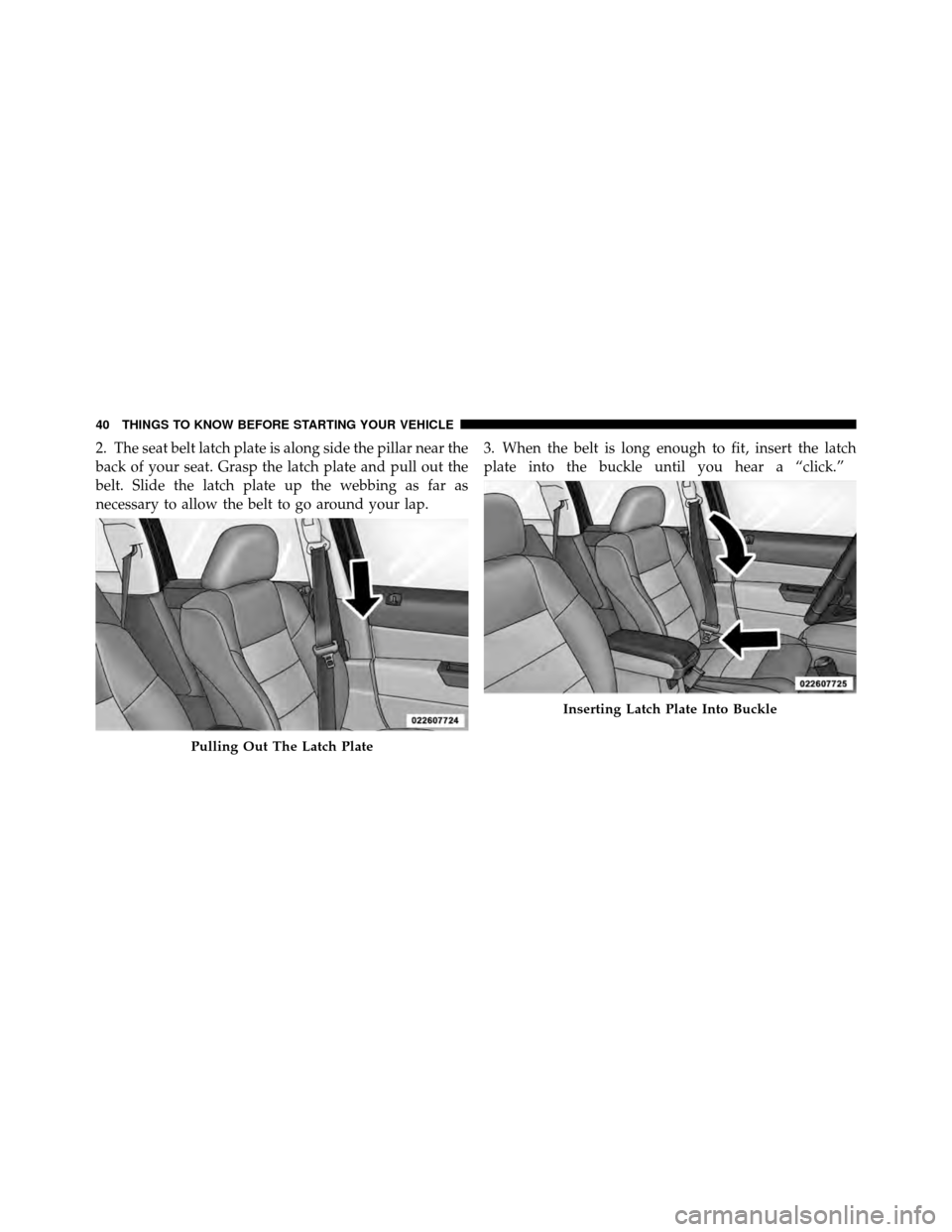
2. The seat belt latch plate is along side the pillar near the
back of your seat. Grasp the latch plate and pull out the
belt. Slide the latch plate up the webbing as far as
necessary to allow the belt to go around your lap.3. When the belt is long enough to fit, insert the latch
plate into the buckle until you hear a “click.”
Pulling Out The Latch Plate
Inserting Latch Plate Into Buckle
40 THINGS TO KNOW BEFORE STARTING YOUR VEHICLE
Page 42 of 496
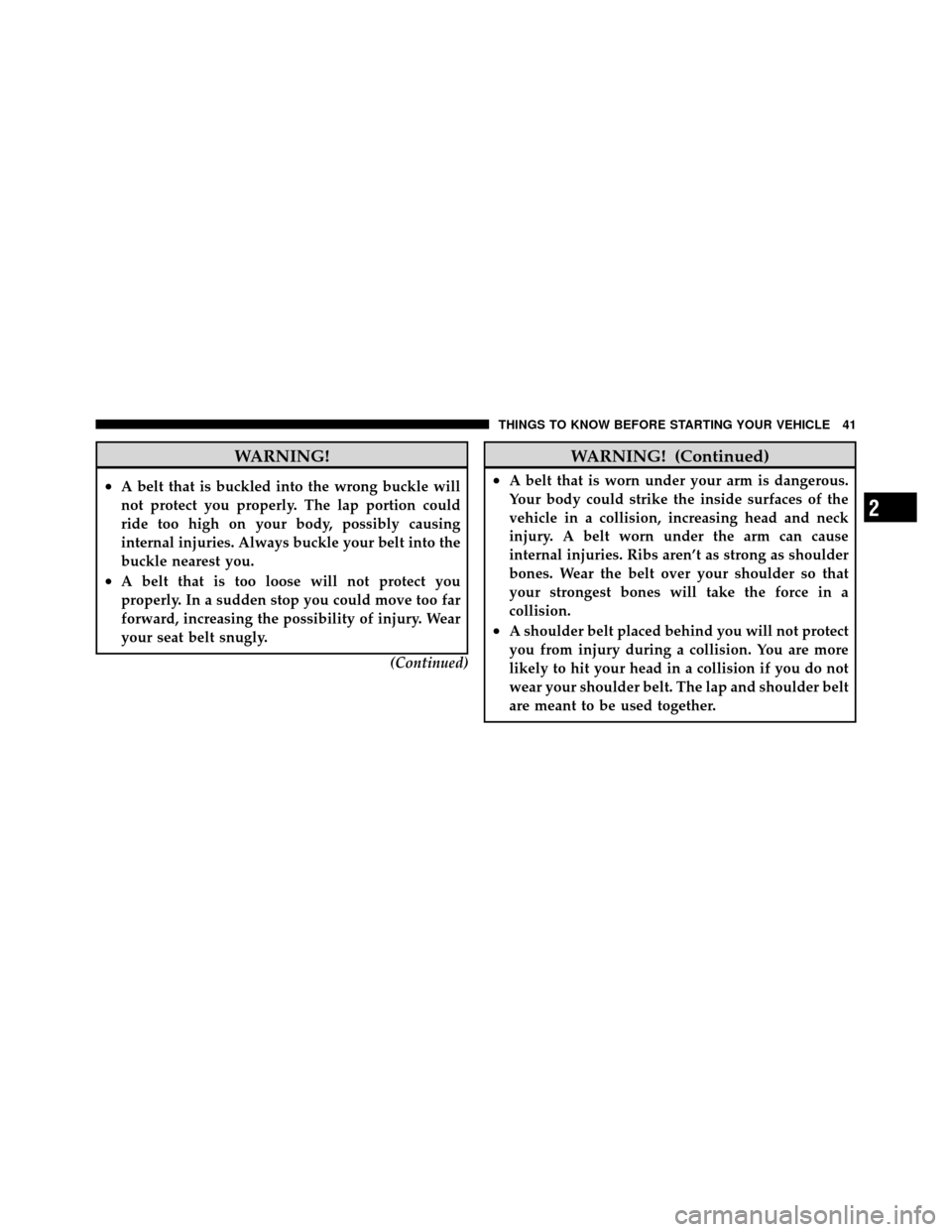
WARNING!
•A belt that is buckled into the wrong buckle will
not protect you properly. The lap portion could
ride too high on your body, possibly causing
internal injuries. Always buckle your belt into the
buckle nearest you.
•A belt that is too loose will not protect you
properly. In a sudden stop you could move too far
forward, increasing the possibility of injury. Wear
your seat belt snugly.(Continued)
WARNING! (Continued)
•A belt that is worn under your arm is dangerous.
Your body could strike the inside surfaces of the
vehicle in a collision, increasing head and neck
injury. A belt worn under the arm can cause
internal injuries. Ribs aren’t as strong as shoulder
bones. Wear the belt over your shoulder so that
your strongest bones will take the force in a
collision.
•A shoulder belt placed behind you will not protect
you from injury during a collision. You are more
likely to hit your head in a collision if you do not
wear your shoulder belt. The lap and shoulder belt
are meant to be used together.
2
THINGS TO KNOW BEFORE STARTING YOUR VEHICLE 41
Page 43 of 496
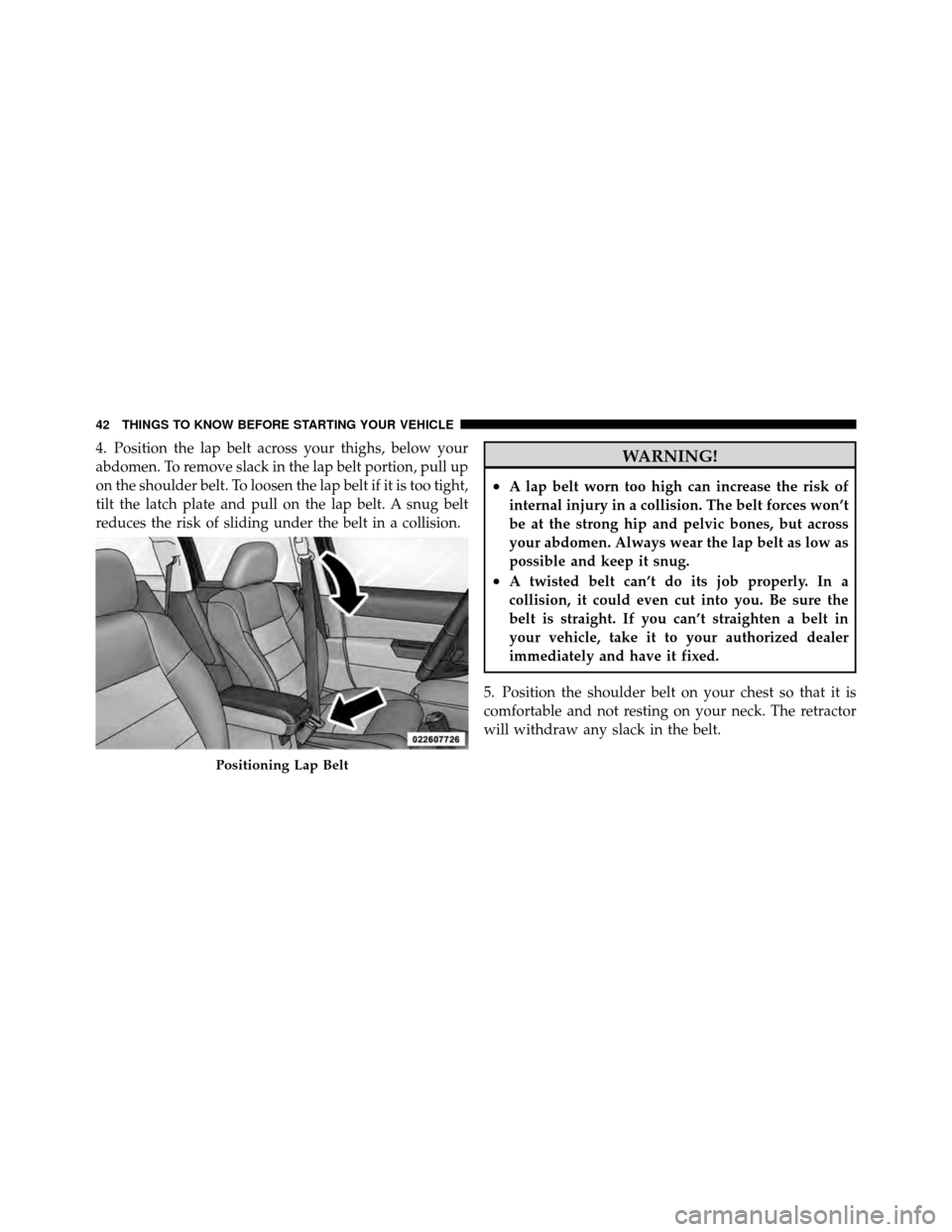
4. Position the lap belt across your thighs, below your
abdomen. To remove slack in the lap belt portion, pull up
on the shoulder belt. To loosen the lap belt if it is too tight,
tilt the latch plate and pull on the lap belt. A snug belt
reduces the risk of sliding under the belt in a collision.WARNING!
•A lap belt worn too high can increase the risk of
internal injury in a collision. The belt forces won’t
be at the strong hip and pelvic bones, but across
your abdomen. Always wear the lap belt as low as
possible and keep it snug.
•A twisted belt can’t do its job properly. In a
collision, it could even cut into you. Be sure the
belt is straight. If you can’t straighten a belt in
your vehicle, take it to your authorized dealer
immediately and have it fixed.
5. Position the shoulder belt on your chest so that it is
comfortable and not resting on your neck. The retractor
will withdraw any slack in the belt.
Positioning Lap Belt
42 THINGS TO KNOW BEFORE STARTING YOUR VEHICLE
Page 44 of 496
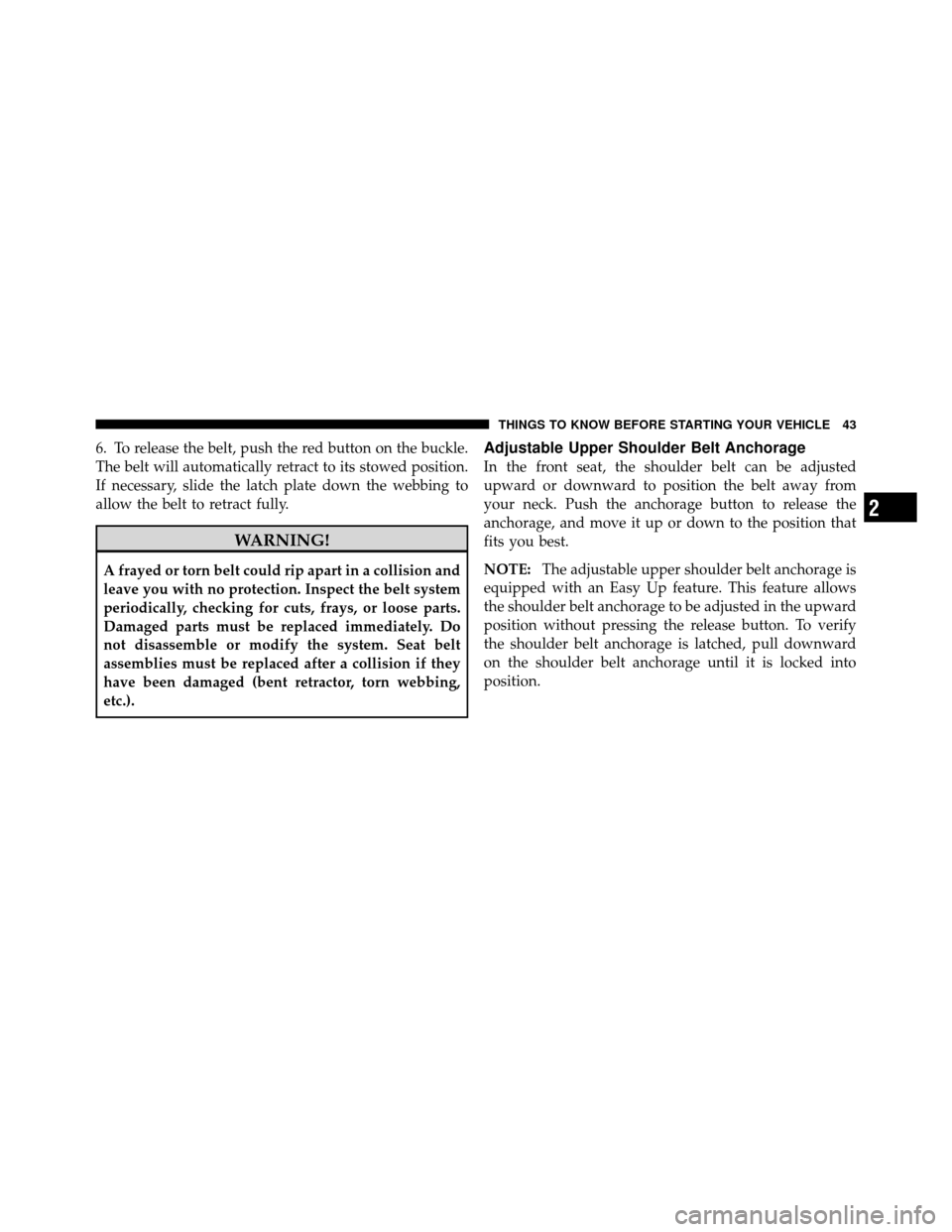
6. To release the belt, push the red button on the buckle.
The belt will automatically retract to its stowed position.
If necessary, slide the latch plate down the webbing to
allow the belt to retract fully.
WARNING!
A frayed or torn belt could rip apart in a collision and
leave you with no protection. Inspect the belt system
periodically, checking for cuts, frays, or loose parts.
Damaged parts must be replaced immediately. Do
not disassemble or modify the system. Seat belt
assemblies must be replaced after a collision if they
have been damaged (bent retractor, torn webbing,
etc.).
Adjustable Upper Shoulder Belt Anchorage
In the front seat, the shoulder belt can be adjusted
upward or downward to position the belt away from
your neck. Push the anchorage button to release the
anchorage, and move it up or down to the position that
fits you best.
NOTE:The adjustable upper shoulder belt anchorage is
equipped with an Easy Up feature. This feature allows
the shoulder belt anchorage to be adjusted in the upward
position without pressing the release button. To verify
the shoulder belt anchorage is latched, pull downward
on the shoulder belt anchorage until it is locked into
position.
2
THINGS TO KNOW BEFORE STARTING YOUR VEHICLE 43
Page 45 of 496
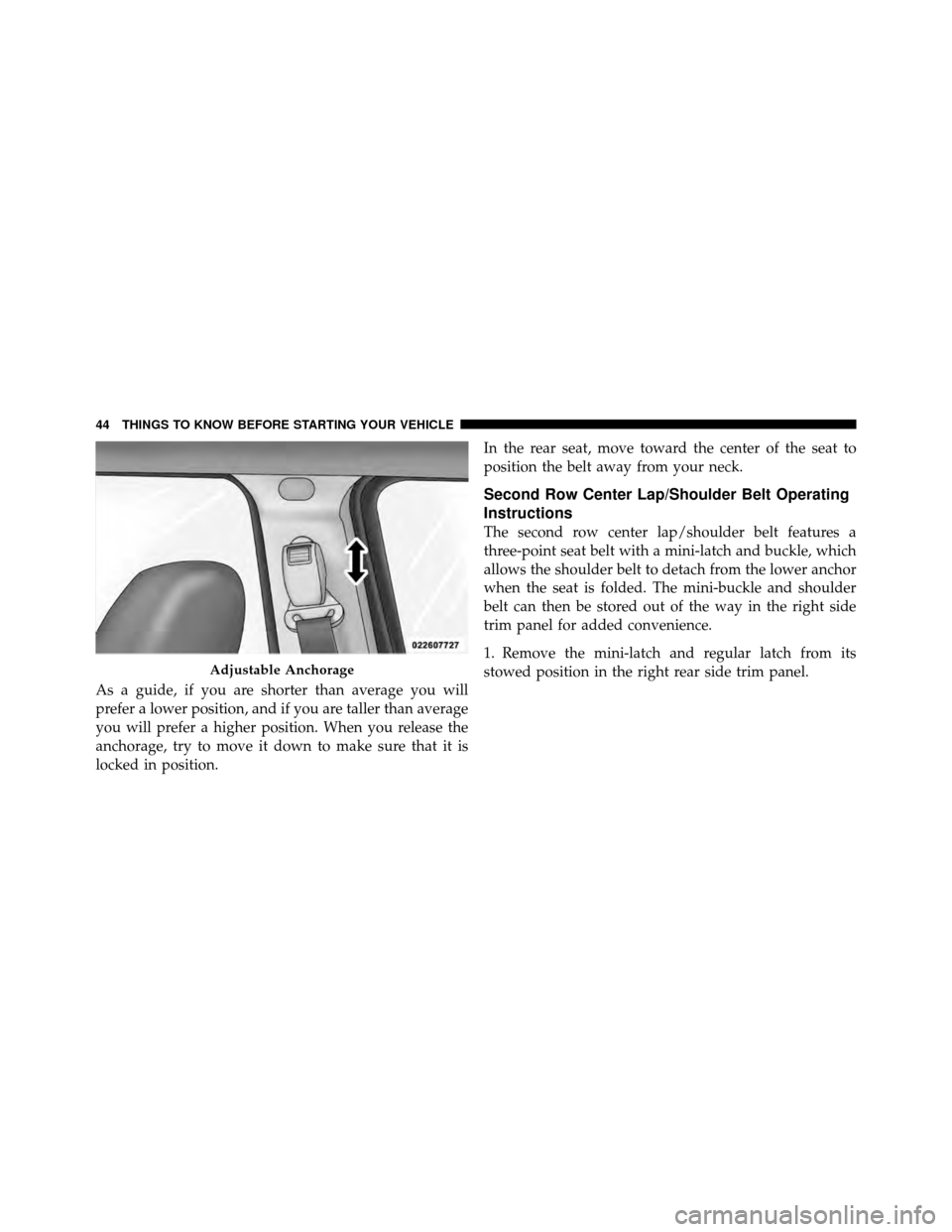
As a guide, if you are shorter than average you will
prefer a lower position, and if you are taller than average
you will prefer a higher position. When you release the
anchorage, try to move it down to make sure that it is
locked in position.In the rear seat, move toward the center of the seat to
position the belt away from your neck.
Second Row Center Lap/Shoulder Belt Operating
Instructions
The second row center lap/shoulder belt features a
three-point seat belt with a mini-latch and buckle, which
allows the shoulder belt to detach from the lower anchor
when the seat is folded. The mini-buckle and shoulder
belt can then be stored out of the way in the right side
trim panel for added convenience.
1. Remove the mini-latch and regular latch from its
stowed position in the right rear side trim panel.
Adjustable Anchorage
44 THINGS TO KNOW BEFORE STARTING YOUR VEHICLE
Page 46 of 496
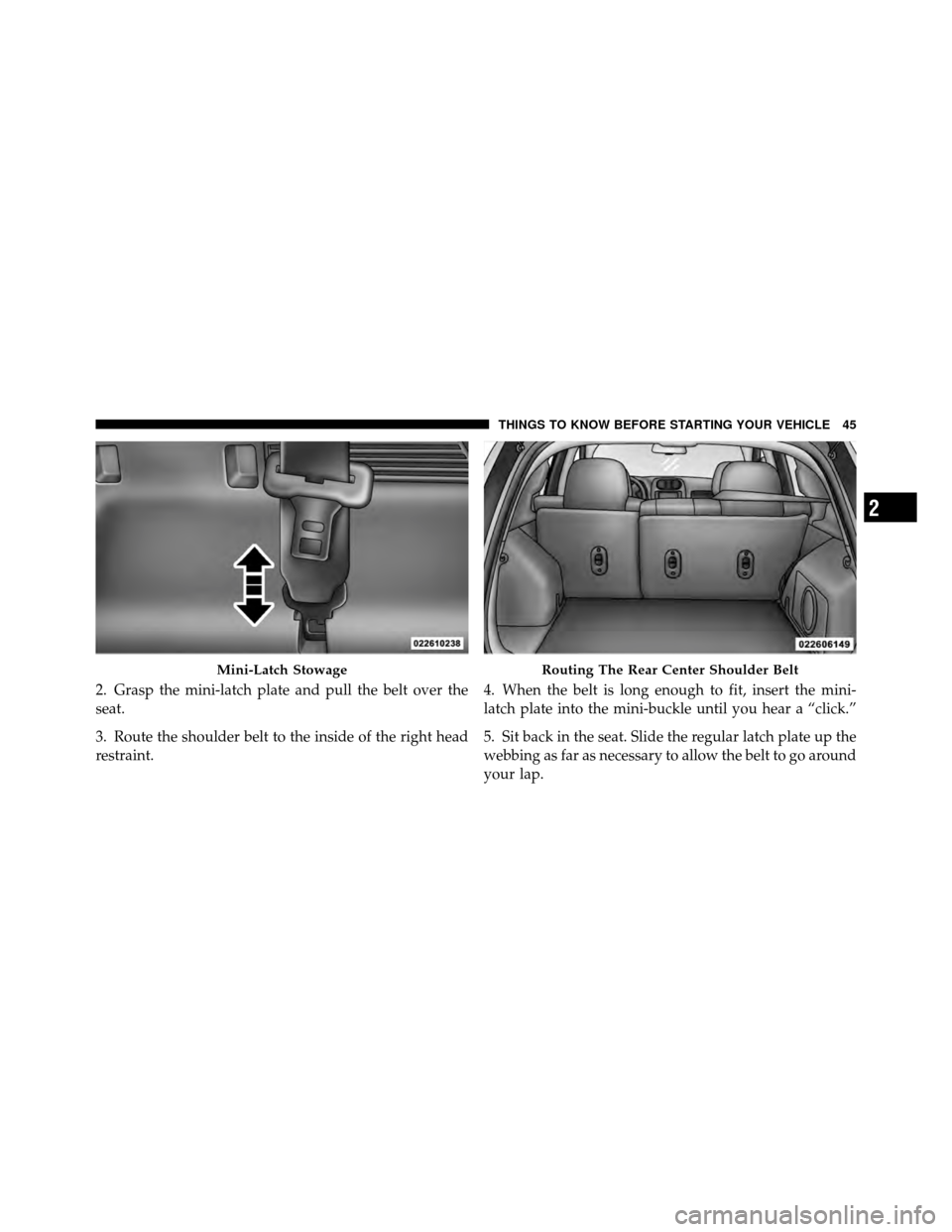
2. Grasp the mini-latch plate and pull the belt over the
seat.
3. Route the shoulder belt to the inside of the right head
restraint.4. When the belt is long enough to fit, insert the mini-
latch plate into the mini-buckle until you hear a “click.”
5. Sit back in the seat. Slide the regular latch plate up the
webbing as far as necessary to allow the belt to go around
your lap.
Mini-Latch StowageRouting The Rear Center Shoulder Belt
2
THINGS TO KNOW BEFORE STARTING YOUR VEHICLE 45
Page 47 of 496
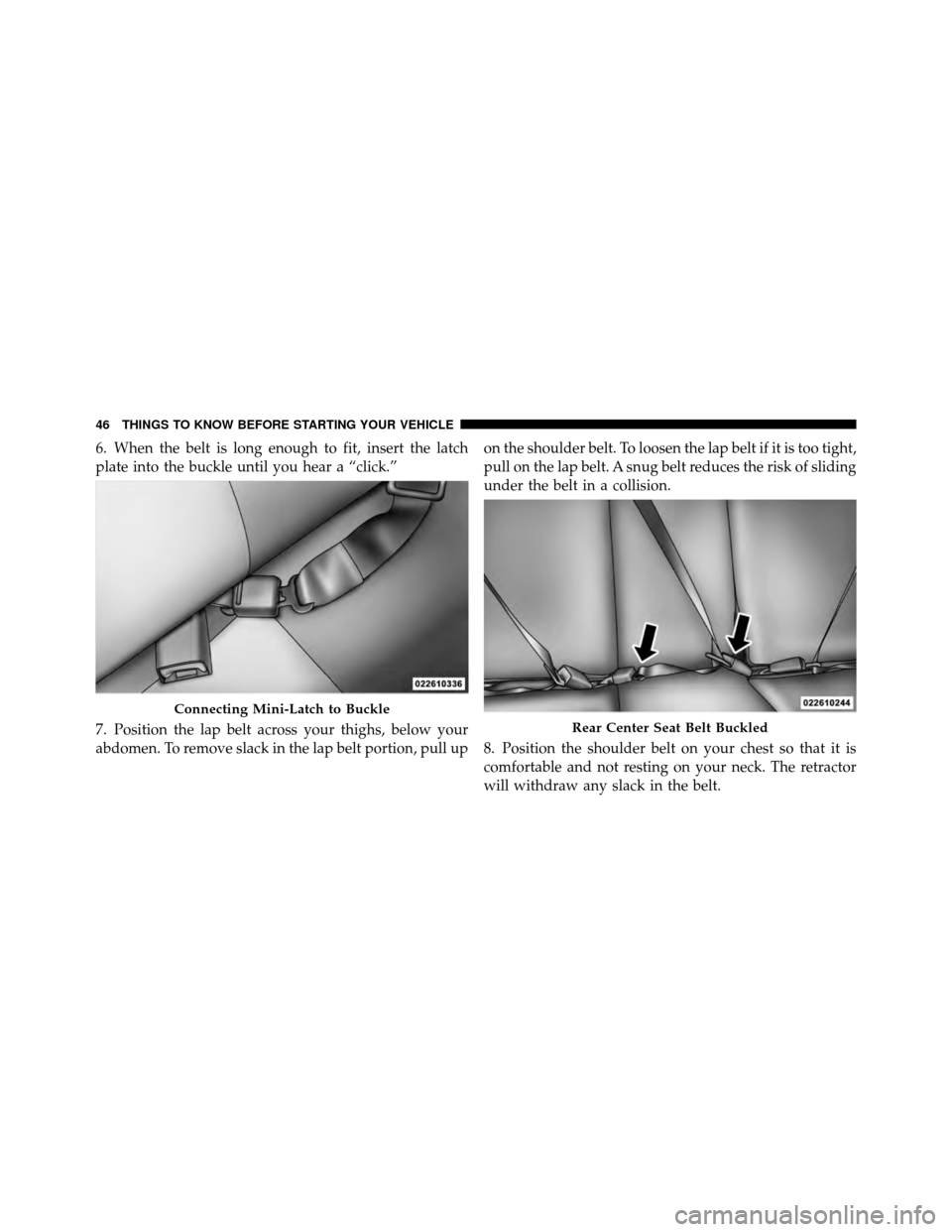
6. When the belt is long enough to fit, insert the latch
plate into the buckle until you hear a “click.”
7. Position the lap belt across your thighs, below your
abdomen. To remove slack in the lap belt portion, pull upon the shoulder belt. To loosen the lap belt if it is too tight,
pull on the lap belt. A snug belt reduces the risk of sliding
under the belt in a collision.
8. Position the shoulder belt on your chest so that it is
comfortable and not resting on your neck. The retractor
will withdraw any slack in the belt.
Connecting Mini-Latch to Buckle
Rear Center Seat Belt Buckled
46 THINGS TO KNOW BEFORE STARTING YOUR VEHICLE
Page 48 of 496
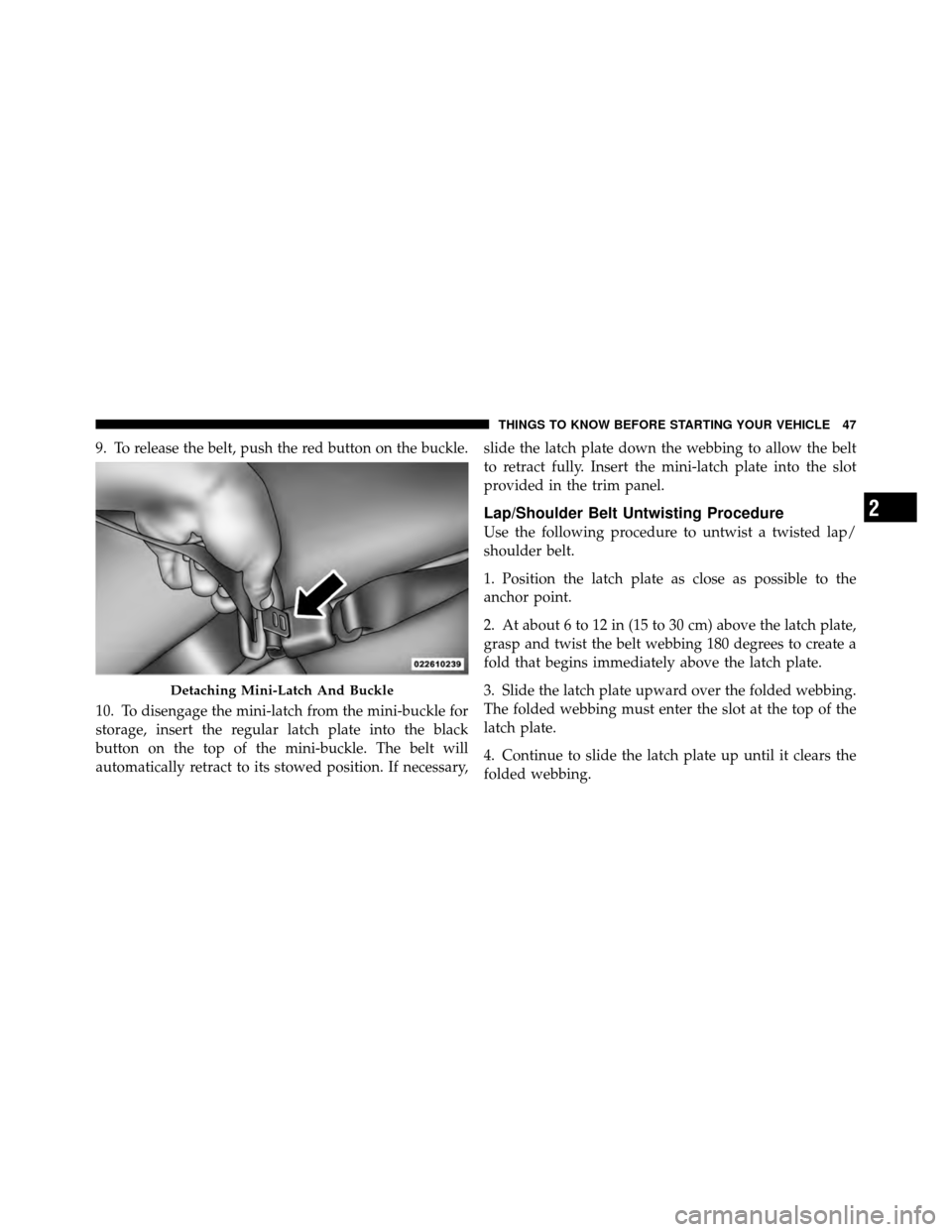
9. To release the belt, push the red button on the buckle.
10. To disengage the mini-latch from the mini-buckle for
storage, insert the regular latch plate into the black
button on the top of the mini-buckle. The belt will
automatically retract to its stowed position. If necessary,slide the latch plate down the webbing to allow the belt
to retract fully. Insert the mini-latch plate into the slot
provided in the trim panel.
Lap/Shoulder Belt Untwisting Procedure
Use the following procedure to untwist a twisted lap/
shoulder belt.
1. Position the latch plate as close as possible to the
anchor point.
2. At about 6 to 12 in (15 to 30 cm) above the latch plate,
grasp and twist the belt webbing 180 degrees to create a
fold that begins immediately above the latch plate.
3. Slide the latch plate upward over the folded webbing.
The folded webbing must enter the slot at the top of the
latch plate.
4. Continue to slide the latch plate up until it clears the
folded webbing.
Detaching Mini-Latch And Buckle
2
THINGS TO KNOW BEFORE STARTING YOUR VEHICLE 47
Page 49 of 496
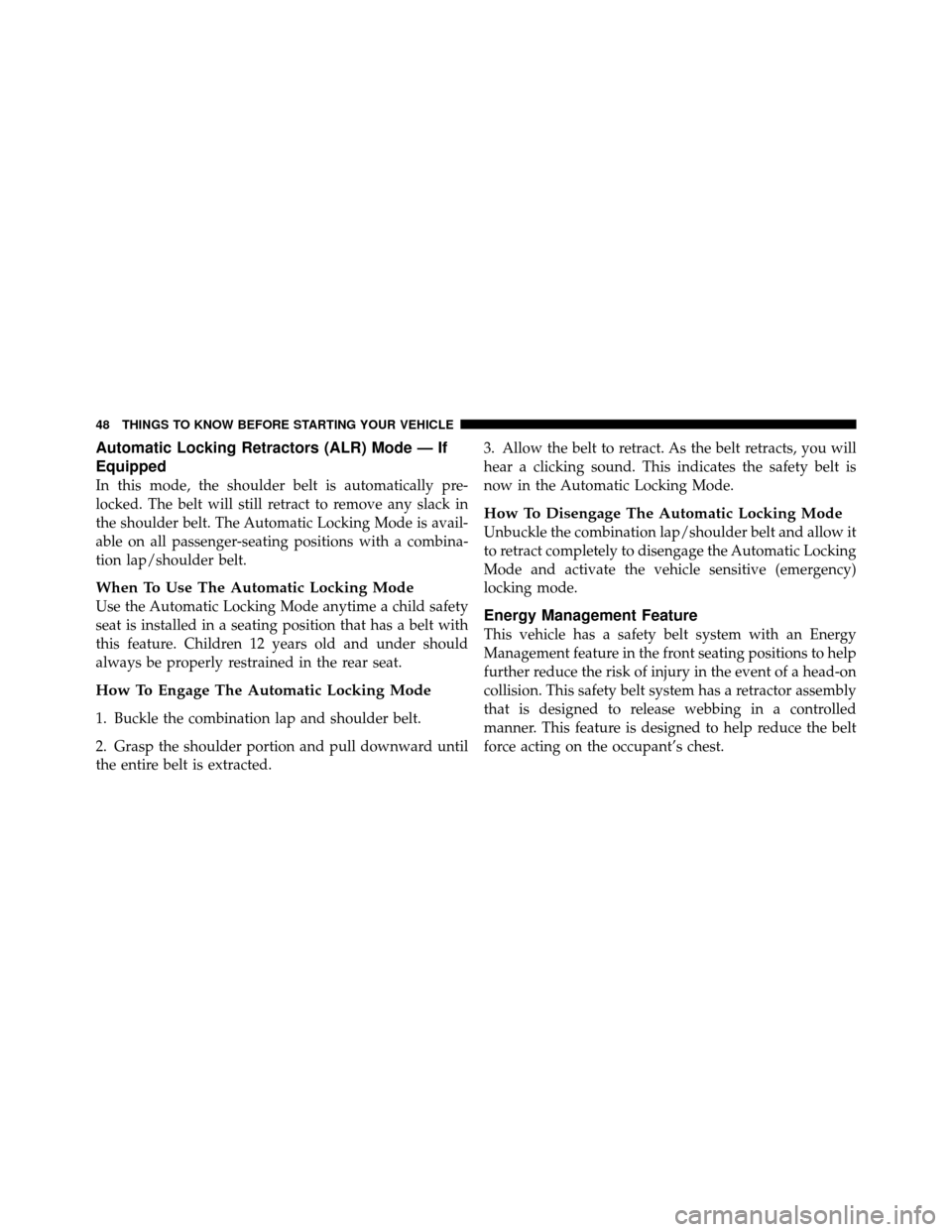
Automatic Locking Retractors (ALR) Mode — If
Equipped
In this mode, the shoulder belt is automatically pre-
locked. The belt will still retract to remove any slack in
the shoulder belt. The Automatic Locking Mode is avail-
able on all passenger-seating positions with a combina-
tion lap/shoulder belt.
When To Use The Automatic Locking Mode
Use the Automatic Locking Mode anytime a child safety
seat is installed in a seating position that has a belt with
this feature. Children 12 years old and under should
always be properly restrained in the rear seat.
How To Engage The Automatic Locking Mode
1. Buckle the combination lap and shoulder belt.
2. Grasp the shoulder portion and pull downward until
the entire belt is extracted.3. Allow the belt to retract. As the belt retracts, you will
hear a clicking sound. This indicates the safety belt is
now in the Automatic Locking Mode.
How To Disengage The Automatic Locking Mode
Unbuckle the combination lap/shoulder belt and allow it
to retract completely to disengage the Automatic Locking
Mode and activate the vehicle sensitive (emergency)
locking mode.
Energy Management Feature
This vehicle has a safety belt system with an Energy
Management feature in the front seating positions to help
further reduce the risk of injury in the event of a head-on
collision. This safety belt system has a retractor assembly
that is designed to release webbing in a controlled
manner. This feature is designed to help reduce the belt
force acting on the occupant’s chest.
48 THINGS TO KNOW BEFORE STARTING YOUR VEHICLE
Page 50 of 496
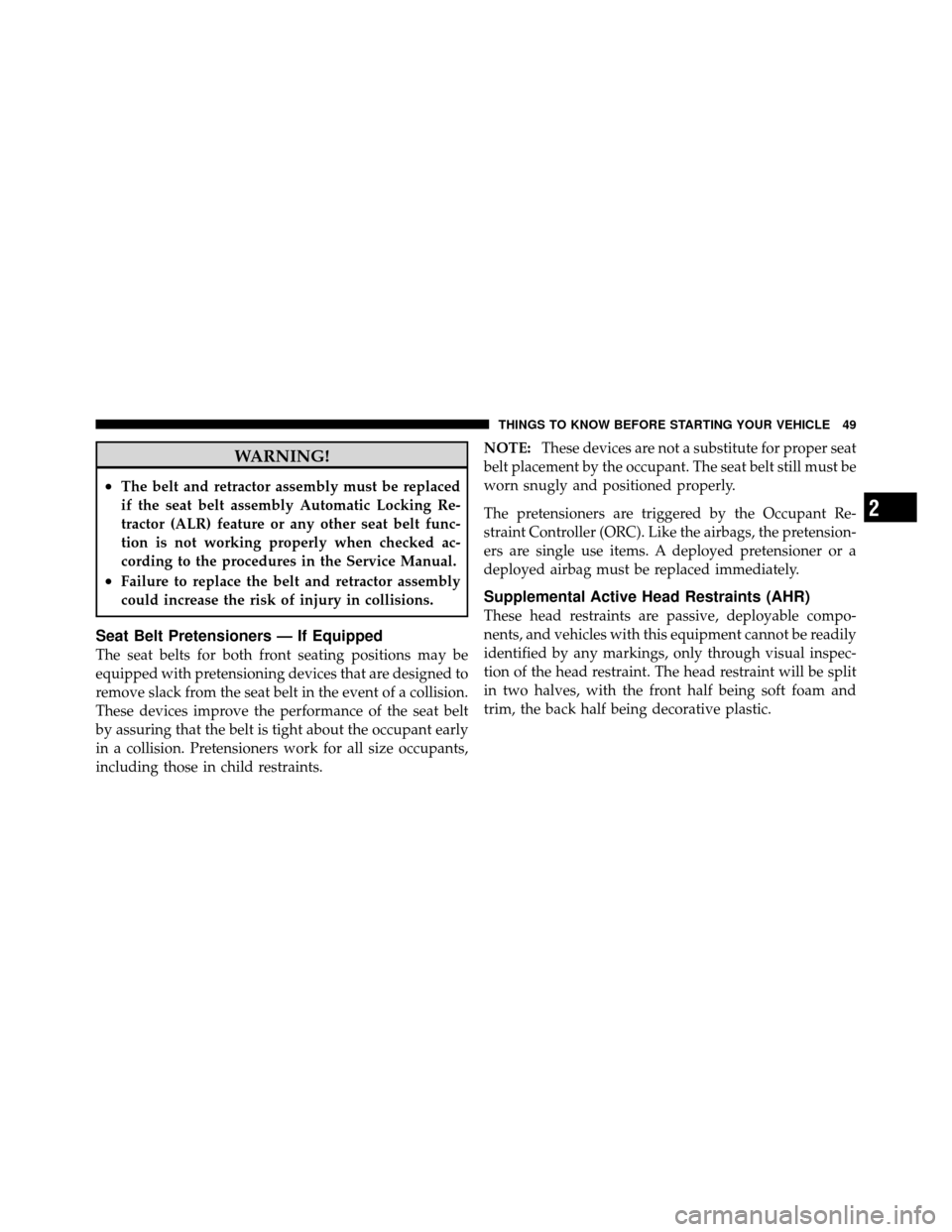
WARNING!
•The belt and retractor assembly must be replaced
if the seat belt assembly Automatic Locking Re-
tractor (ALR) feature or any other seat belt func-
tion is not working properly when checked ac-
cording to the procedures in the Service Manual.
•Failure to replace the belt and retractor assembly
could increase the risk of injury in collisions.
Seat Belt Pretensioners — If Equipped
The seat belts for both front seating positions may be
equipped with pretensioning devices that are designed to
remove slack from the seat belt in the event of a collision.
These devices improve the performance of the seat belt
by assuring that the belt is tight about the occupant early
in a collision. Pretensioners work for all size occupants,
including those in child restraints.NOTE:
These devices are not a substitute for proper seat
belt placement by the occupant. The seat belt still must be
worn snugly and positioned properly.
The pretensioners are triggered by the Occupant Re-
straint Controller (ORC). Like the airbags, the pretension-
ers are single use items. A deployed pretensioner or a
deployed airbag must be replaced immediately.
Supplemental Active Head Restraints (AHR)
These head restraints are passive, deployable compo-
nents, and vehicles with this equipment cannot be readily
identified by any markings, only through visual inspec-
tion of the head restraint. The head restraint will be split
in two halves, with the front half being soft foam and
trim, the back half being decorative plastic.
2
THINGS TO KNOW BEFORE STARTING YOUR VEHICLE 49